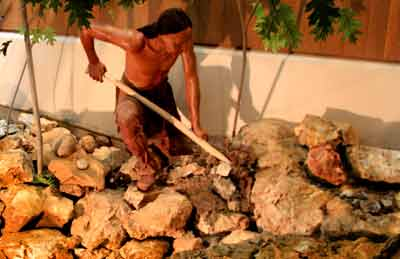
Large section of Flint on display at the Flint Ridge Memorial
Flint Ridge
Nothing can really compare the role that flint played in the development of this area over the last 9,000 years, unless you compared it to today's need for oil. Today, our entire civilization depends on oil and all of its derivatives. In the early pre-historic ages, the same could be said for flint.
 Flint was a mineral could easily be carried in bulk in such a form that they could quickly knock off a small slab, form it up into a tool with razor sharp edges, keener than any steel blade. Quality flint was used to create arrow and spear points necessary for hunting and defense. It was also used in the preparation of food, utensils, awls, hatchets, scrapers and knives. Without flint, early man would have been hunting with nothing more than sharpened sticks.
Flint was a mineral could easily be carried in bulk in such a form that they could quickly knock off a small slab, form it up into a tool with razor sharp edges, keener than any steel blade. Quality flint was used to create arrow and spear points necessary for hunting and defense. It was also used in the preparation of food, utensils, awls, hatchets, scrapers and knives. Without flint, early man would have been hunting with nothing more than sharpened sticks.
Flint is formed by a a geologic process whereby the softer limestones and shales are replaced with a much harder silica that creates a form of quartz. Over time the hard, yet brittle forms cracks. It is these cracks that makes it easy to shape. Although flint is much harder than most other stones, the cracks can be manipulated and struck to quickly form the sharpened edges.
Just as oil can be found almost anywhere on the planet if you knew where to look, flint is very similar. What makes the flint found in eastern Ohio Licking and part of Muskingum counties different from other flint deposits is the quality of the flint found there. The flint found there is known as Vanport Flint.
Vanport Flint can be found in many parts of eastern North America. It is an extremely high quality flint
 Today, geochemical variations in Vanport flints can be used to identify the flint retrieved from this area, but also exactly where in the area it was first quarried. It is this highly specialized identification process that tells us how important the Flint Ridge flint was for early inhabitants of North America. Vanport flint from Flint Ridge has been recovered in excavations not only throughout Ohio and the Midwest, but as far east as New York, south to Georgia and Louisiana and as far west and Kansas.
Today, geochemical variations in Vanport flints can be used to identify the flint retrieved from this area, but also exactly where in the area it was first quarried. It is this highly specialized identification process that tells us how important the Flint Ridge flint was for early inhabitants of North America. Vanport flint from Flint Ridge has been recovered in excavations not only throughout Ohio and the Midwest, but as far east as New York, south to Georgia and Louisiana and as far west and Kansas.
Combined with the abundance, quality, and accessibility of the Vanport flint in this one particular area, made the owners of this land very wealthy. Flint from this one area seems to be the most important source of flint for pre-historic cultures and may be one of the reasons this area experienced so much Mound Building activity.
Although evidence suggests that the site was being used some 9,000 years ago by early pre-historic men, many archeologists believe that Flint Ridge was the most active between 2500 and 1500 years ago during the Adena-Hopewell period..
Over the last 150 years, various studies and surveys of the area have been conducted, with the most exhaustive being done in the early 1900s. It was the result of this research that convinced the State of Ohio to set aside the area and preserve it in 1933 as the Flint Ridge State Memorial.

Flint Ridge State Memorial
Flint Ridge State Memorial is named after a narrow range of hills that extend from a few miles east of Newark almost to Zanesville. For more than 10,000 years, prehistoric groups used this area and the outcropping of flint. Flint is found in many places throughout the world, but this area was of particular interest because of it's beautiful color and texture. The layer of fling along this particular ridge ran from a few inches in some places to over 2 feet thick in others.
Part of the park is an excellent museum and gift shop that gives visitors a thorough background on the importance that flint played in the lives of early Ohioans.
In 1934 Flint Ridge became a state memorial to protect the natural beauty of the area as well as preserve its prehistoric and historic past. From studying this area it has been determined that this area was used primarily as a quarry site, and not as a village. Ohio's prehistoric cultures would visit here for short periods of time, long enough to remove enough flint to meet their immediate needs and then move on or return to their permanent villages found throughout the state.

On the grounds there are several trails of varying lengths along with a natural trail for the physically handicapped that provides a hard-surfaced trail with informational signs in both script and braille. Removal of any artifacts or flint is strictly prohibited.
Flint Ridge State Memorial is located just north of I-70 at the Brownsville exit. The museum is open May through October until 5 p.m. A small fee is charged for the museum for non-Ohio Historical Society Members.
Flint Ridge
7091 Brownsville Road, S.E. Glenford, OH 43739


